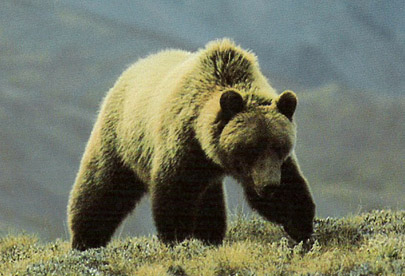
Alberta

Postcard courtesy of Stephanie Wong
While camping, one should never leave food out in the open unattended as it might attract bears. Wildlife must always be respected. In some parks, the feeding of animals is prohibited since the animals might become complacent to humans and wander into populated areas, potentially becoming hazards to both human and itself.
Caption: Grizzly Bear - Ursus arctos © The Postcard Factory
The largest of the living carnivores, grizzly bears, are 150-280 cm in length from head to toe and 90-150 cm tall at the shoulder. Adult males are usually larger than females averaging 300 kg, however along the south coast of Alaska, they can reach weights of up to 780 kg. The Grizzly can be found in western Europe, parts of Siberia, the Himalayan Region and various parts of North America. Grizzly bears are extremely strong and have incredible endurance, often traveling great distances and reaching surprising speeds. The diet of grizzly bears consists mainly of vegetation though grizzly bears can be quite carnivorous hunting elk, salmon and other various animals.
The grizzly bear begins hibernation in October-December and resumes activity in March-May. Dens are sometimes used repeatedly year after year and two offspring are generally born per litter. Baby grizzlies usually remain with their mothers until at least their second spring of life, but may remain until their third or fourth year. Status depends on population and some populations are clearly endangered. The potential life span of the grizzly in captivity is as great as 50 years.
| Home | Contact Us | Credits | Sitemap |
© 2006 - Imagiverse Educational Consortium